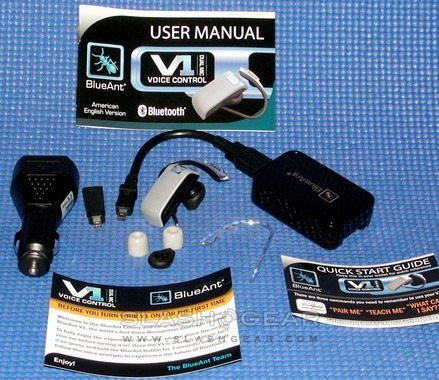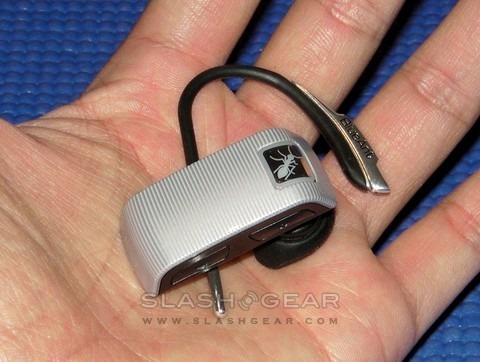BlueAnt V1 Voice Control Bluetooth Headset Review
Talk Bluetooth headsets and the two key names in the business are BlueAnt and Aliph. The two companies take it in turns to hold the top-spot, each trying to outdo the other with noise reduction, added features and general audio quality. For the past few months, Aliph have arguably ruled the roost with their Jawbone 2; now BlueAnt are back with the V1, flaunting a new level of user-independent voice control. Has the headset market flip-flopped back to the Australian company? We've been testing out the BlueAnt V1 for the past few weeks to find out.
It wasn't all that long ago that you'd be looked at oddly for using a Bluetooth headset – people assumed you were talking to yourself – but with the recent proliferation of hands-free driving laws the wireless earpieces have become far more common. At the budget end there are plenty of cheap options, but if you're looking for something more comprehensive then your choices have generally been Aliph or BlueAnt – with the $129.99 price tags to match. Both have above-average sound quality, comfortable fit (with interchangeable ear-buds as standard) and various degrees of background noise cancellation. What BlueAnt bring to the table now is an unprecedented method of voice control, which they're calling BlueGenie.
In terms of hardware, the V1 measures in at a short though mildly tubby 41 x 17.5 x 11.2mm; with the ear-hook it weighs 11g. A non-replaceable Li-Ion battery is quoted as good for up to 5hrs talktime or 200hrs standby, with a MicroUSB socket for recharging (or performing firmware updates). Controls are limited to a multifunction button (with built-in red and blue LEDs) and volume up and down. The V1 supports Bluetooth v2.1 and has a quoted range of 10m; it can hook up to your phone either via the Headset or the Hands-Free profiles.

In the box you get the headset, a range of rubber ear-buds and Comply foam tips, interchangeable rubberized-metal and translucent plastic ear hooks, and a gooseneck USB cable for use with the supplied car charger and AC adaptor. If you'd rather use your cellphone charger (assuming it has a MiniUSB plug) BlueAnt supply an adapter to plug it into the MicroUSB socket.
Voice Isolation uses the dual microphone array to offer echo suppression, noise reduction and wind noise cancellation, with BlueAnt's usual two strength levels: Standard and Max. Switching between them in-call is a matter of pressing the multifunction button. The V1 can pair with up to eight devices (although only one can be active at any time) and uses the standard 0000 passcode.
Comfort is good, with enough ear-bud choice to suit all but the most unusual of wearers. Although you can remove the ear hook and wear the V1 without it, we had mixed results and preferred the security of having it in place. We actually prefer the fit of the earlier BlueAnt Z9i, which felt more snug, although build-quality overall is on a par. Buttons are easy to press.

Of course, BlueGenie is the headline feature here, and it requires a little explanation. Basically, all of the V1's features and settings are controlled by voice commands, using relatively normal speech rather than stilted keywords. Triggered by a press of the multifunction button, the headset prompts you to "Say a command" to which you have a variety of choices. Asking "What can I say?" gives a contextually-relevant list of the current options; for instance, say "Check battery" and the V1 will tell you how much charge it has left.
It might not sound like much, but in practise it's incredibly straightforward. Rather than using the hardware buttons to scroll through interminable menus, trying to decipher multiple coded beeps, you can simply navigate the V1 by voice. Each option or setting is confirmed with another voice prompt, letting you know exactly what it is you've changed, and at any point you can say "Cancel" and start over.

Accuracy is, considering the absence of any training, very good. Different versions of the BlueGenie software will be made for different accents; right now, the US version understandably works best with an American accent. Ironically, this is a headset you could really begin using without looking at the manual – say "Tips and Tricks" and it will verbally explain some of the cooler features, even – but if you do that you'll probably only be enjoying half of its abilities.
The V1 supports voice-activated favorites dialling, which can be set up in two different ways. Out of the box, it assumes you have programmed your cellphone's speed-dials with Voicemail as key one, home as key two and office as key three; saying "Call home" will then automatically trigger the key two speed-dial. Of course, if your home number is key three, then you'll need to say "Call office" to dial it; the V1 doesn't know what the number is, only associates the command with the speed-dial position.
Alternatively, you can programme specific numbers into the V1 itself. This requires you to receive a call from that number; you then hold the volume down button for three seconds. The headset asks you which voice command to associate with that number. BlueAnt have pre-programmed Google's GOOG-411 voice-guided directory enquiries number into the headset, triggered by saying "Call GOOG-411" (the company tells us that future versions of the headset could see other services added, although right now it's a Google exclusive).
It's a good system in that it's phone-independent, although the inability to change the tags ("office", "home", etc) is a little restrictive. We would've liked to be able to actively voice dial, too, telling the V1 which number to call. However it puts the BlueAnt ahead as it means – with some careful Favorites list planning – you can now use voice dialling with the iPhone. The second number in your iPhone Favorites list will correspond with telling the BlueAnt to "Call Home", and so on.

BlueGenie handles incoming calls, too, reading out the number (though not the caller ID name) and letting you answer or reject by saying "Answer" or "Ignore" (alternatively you can press the multifunction key once or twice to do the same thing).
Audio quality is a mixed bag. The Voice Isolation goes from Standard, suitable for normal environments, such as the office or at home, to Max, which is a lot more draconian. BlueAnt describe the Max setting as intended to make your voice "more intelligible", and in the process you do lose some intonation and subtlety. However it does a reasonable job of cutting out engine noise or wind.
What's revolutionary about the BlueAnt V1 is the BlueGenie voice control engine. Nothing else on the market can come close to it, and that's backed up with sound quality that's the equal of Aliph's Jawbone 2. If we had any criticism, it would be about the fit: while the V1 is okay, it's slightly edged out by the Jawbone 2's snug fit and the Z9i's super-comfortable earpiece. Undoubtedly subjective factors, though; what we can say with far more certainty is that the V1 is one of a kind. BlueAnt might not score a knockout blow against Aliph in terms of audio, but it's the voice control that eventually gives the V1 the edge.
The BlueAnt V1 is available now, priced at $129.99. Check out the full SlashGear V1 gallery hereUnboxing Video:
